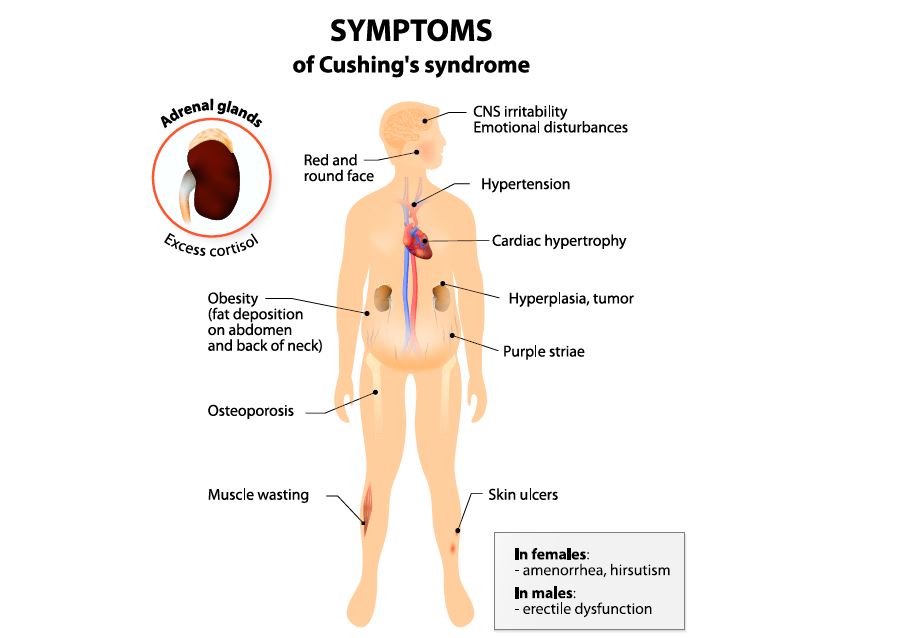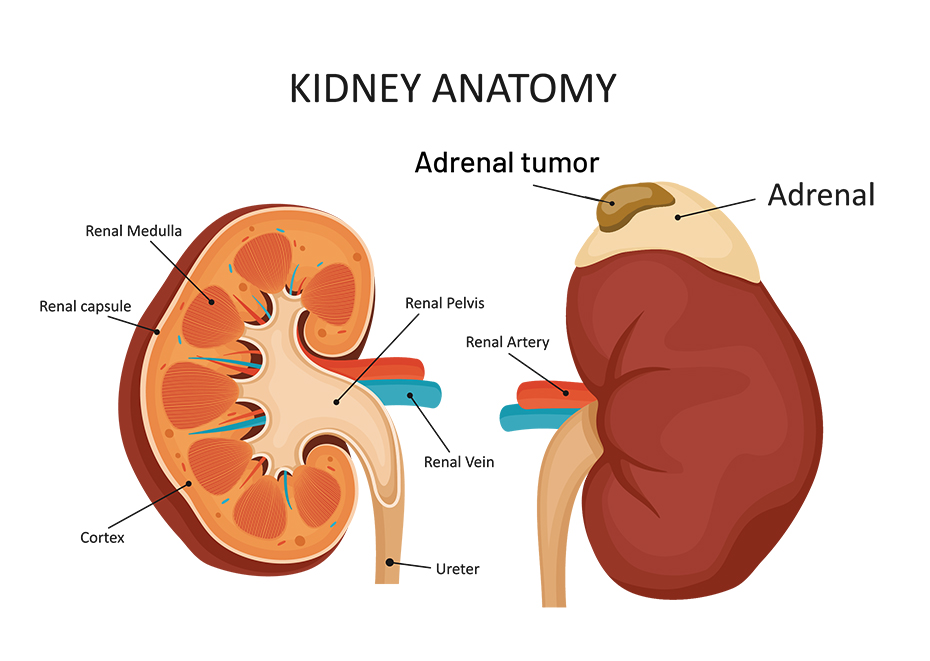
Hormones are important substances created by your endocrine glands. Think of them as messengers that control and coordinate many activities in the body including development, metabolism, reproduction, mood, and other functions. Unbalanced hormones can cause serious and life-altering symptoms and diseases such as Cushing’s syndrome, which is a disorder of high cortisol levels in the body.
In this article, you can learn more about what Cushing’s syndrome is, prevention, signs of the disorder, risk factors, and treatment options.
What is Cushing’s Syndrome?
Cushing’s Syndrome is a medical condition characterized by prolonged exposure to high cortisol levels, a hormone produced by the adrenal glands. Cushing’s Syndrome is the term used when there is an abnormal, very high level of cortisol in the blood.This condition can result from various causes, including endogenous sources like tumors or exogenous factors such as prolonged steroid use. The primary causes of Cushing’s Syndrome include pituitary tumors, adrenal tumors, ectopic tumors, and excessive use of corticosteroids.
What causes of high cortisol levels?
There are four main triggers as it relates to Cushing’s syndrome. Finding the source of the excess cortisol is important because it determines the course of treatment.
Pituitary tumor
A pituitary tumor is an abnormal growth or mass that develops in the pituitary gland, which is a small pea-sized gland located at the base of the brain. The pituitary gland plays a crucial role in regulating various bodily functions by producing and secreting hormones that control growth, metabolism, reproduction, and other important processes. Tumors of the pituitary gland, also known as Cushing’s disease, cause 70-80% of Cushing’s syndrome. Pituitary tumors can be classified as either non-cancerous (benign) or cancerous (malignant). Most pituitary tumors are benign and do not spread to other parts of the body.
Adrenal tumor
Adrenal tumors can be categorized into several types including adrenal Cortex Tumors (tumors that originate from the outer layer of the adrenal gland), and adrenal Medulla Tumors (tumors that arise from the inner part (medulla) of the adrenal gland and are usually rare). Either can be benign (non-cancerous) or malignant (cancerous). Adrenal tumors areresponsible for about 10% of Cushing’s syndrome. The tumor is usually a bilateral adrenal hyperplasia or benign (non-cancerous) adrenal nodule that is making cortisol in excess. Adrenal cancer produces excess cortisol about half of the time, but it is an extremely rare tumor.
Ectopic tumor
About 10% of patients with Cushing’s syndrome have an ectopic cancer, most often in the lung that makes cortisol or a related steroid hormone. An ectopic tumor refers to a tumor that develops in a location outside of its normal or usual place in the body. The term “ectopic” comes from Greek roots meaning “out of place” or “away from the usual position.” If a type of tumor originates in one organ but develops in another unrelated organ, it can be described as ectopic. Examples of ectopic tumors include ectopic adrenocortical carcinoma (a rare cancer that usually originates in the adrenal glands), ectopic thyroid tumor (develops in the thyroid gland, which is located in the neck), and ectopic parathyroid adenoma (benign tumors that typically develop within the parathyroid glands, which are located near the thyroid gland in the neck).
Excessive steroid use
Cushing syndrome may be the result of using corticosteroid medications for a long time. Corticosteroids may be prescribed to manage asthma, arthritis, and other diseases.
Other drivers of high cortisol
Prolonged emotional or physical stress can lead to sustained high levels of cortisol as part of the body’s stress response system. This is often termed “stress-induced hypercortisolism. Certain medications, especially those that are corticosteroids (like dexamethasone or hydrocortisone), can also increase cortisol levels in the body if used for extended periods or in high doses. In addition, serious illnesses or injuries can cause the body to produce more cortisol as part of the stress response. Conditions like severe infections or trauma can lead to temporary increases in cortisol levels. Chronic alcohol abuse is another factor that can affect the adrenal glands and the hypothalamic-pituitary-adrenal (HPA) axis, leading to altered cortisol levels. Naturally, cortisol levels can increase in women during pregnancy, which is due to the production of hormones by the placenta. Lastly, conditions such as depression and anxiety have been associated with elevated cortisol levels. These conditions can disrupt the normal regulation of the HPA axis.
Symptoms and Signs of Cushing’s Syndrome
While there are several distinguishable signs and symptoms of Cushing’s disease, some patients may have subclinical Cushing’s, having few symptoms. These patients still require treatment and are identified by having abnormal lab results. Symptoms and signs of Cushing’s syndrome which include fatigue or muscle weakness, mid-section weight gain, bruising easily, and swelling in the legs. They may also experience wide-ranging mood swings, irregular periods (women), and mental fogginess. High blood pressure is also prevalent including a rounder (moon shaped) face, diabetes, osteoporosis, abnormal hair growth, and a lump, or hump, on the back of the neck (buffalo hump)
For additional information including diagnosing Cushing’s Syndrome, risk factors, treatment, and answers to common questions, please see:
Conditions > Cushing’s Syndrome-Adrenal
Please also visit our Center for Endocrine Tumors and Disorders.
Written by Melanie Goldfarb, M.D., Associate Professor of Surgery, Director for the Endocrine Tumors and Disorders Center, and Medical Director for Cancer Survivorship at the Saint John’s Cancer Institute.


